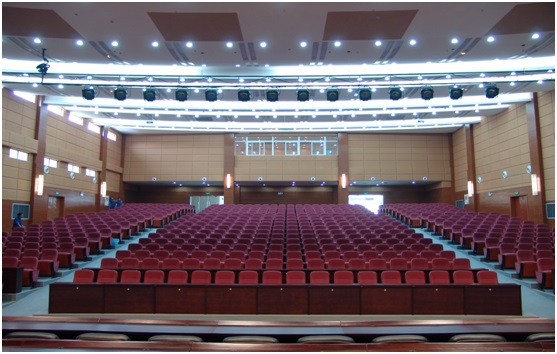The auditorium chair is composed of four parts: a seat, a back, an armrest and a standing leg. Under normal circumstances, the standing feet and the handrails are integrated to form a firmly installed handrail frame, and the composition structure is generally a steel-wood structure or a steel-plastic structure.
1. The scope of use of auditorium chairs
It is suitable for theaters, auditoriums, lecture halls and other places. It should have a good line of sight during meetings and performances. The seat should be easy to maintain and clean, and it should be comfortable when used and not easy to fatigue.
2. Design features of auditorium chair
In most cases, sofa-like cushions are used. In order to facilitate the evacuation of people, the cushions can be turned over. According to the needs of use and on-site design, the seats of the auditorium need to be placed with documents and writing boards for recording. Special auditoriums also require consideration of the combination of simultaneous translation equipment and voting and speaking equipment.

3. Detailed introduction to the structure of the auditorium chair
a. Auditorium chair standing foot
There are two types: landing on one foot and landing on the armrest.
The one-legged seat supports the center point of the seat by standing feet. In addition to its beauty, it is also convenient to use the feet of the chair to connect with other facilities in the environment, such as vents, power connections, etc.
The way the armrest stands on the ground is firm and reliable, and it is convenient to fix and install. The armrest frame and the stand are combined, and the structure is simple.
The standing foot is the foundation of the auditorium chair support and is usually fixed directly on the ground with anchor bolts.
b. Auditorium chair armrests
The armrest of the auditorium chair is the basic support of the entire seat, and the main parts of the seat are connected with the armrest. The armrest is mainly composed of a metal frame, an armrest board and a writing board structure.
c. Auditorium seat bag
Generally, it is composed of fabric, sponge pad, inner frame, rotating mechanism and outer plate.
Fabric: Fabrics such as hemp, velveteen or car velvet are generally used; some are made of genuine leather or imitation leather.
Sponge pad: It is made of PU (polyurethane) foam with a density of 40-60Kg/M3.
Inner frame: According to different designs, curved wood and plastic panels are used for simple structures, and spring metal frames are used for high-end seats.
Rotation mechanism: It is divided into gravity recovery mechanism and spring recovery mechanism. The gravity recovery mechanism is simple and reliable without maintenance. It is often equipped with rubber silencers to eliminate impact and noise during recovery; spring recovery can make the volume of the recovery mechanism smaller, and the structure design Flexible and changeable, after adding the damping device, the return movement can be controlled, the movement becomes slow, and the impact and noise are completely eliminated;
Outer panel: It can be made of wood, plastic or other materials according to the design needs. The main function is to decorate and connect with the recovery mechanism.
d. Auditorium chair backpack
It is generally composed of fabric, sponge pad, inner lining board and outer board.
Fabric: Fabrics such as hemp, velveteen or car velvet are generally used; some are made of genuine leather or imitation leather.
Sponge pad: It is made of PU (polyurethane) foam with a density of 35-50kg/m³.